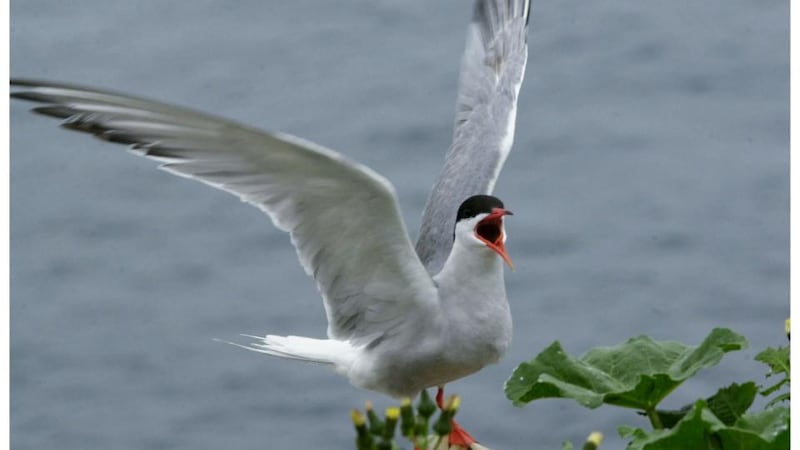When details of a large wind farm planned for off the coast of counties Dublin, Meath and Louth began to emerge, Teddy Otto, who is living “right on the beach” in Skerries, said to himself: “Sure, it will be grand.
“I would describe myself as green in spirit. I fully accept global warming is happening. In principle, I’m in favour of wind energy,” says Otto.
He eventually concluded the scale of the North Irish Sea Array (NISA) was inappropriate given its location – a consequence of an “imposed designation 25 years ago” without proper prior environmental evaluation. “It’s not a sensitive way of doing it. It ticks the sustainability box but not on wildlife and proximity to the coastline.”
The threat to nearby Rockabill island is Otto’s prime concern. It supports Europe’s largest breeding bird colony of endangered roseate terns. He and others help clean up Rockabill and nearby islands using a currach built through the Currachaí na Sceirí initiative, a community of boatbuilding rowers and enthusiasts of traditional currachs.
“I have a sea view – I love it,” he says. Looking out from the South Strand in Skerries, everything to the right of Rockabill will be unaffected if NISA happens; to the left, however, the skyline will be filled by large turbines.
“That doesn’t bother me so much. If there was no alternative, I would say ‘do it’. I firmly believe there are better alternatives; they may still be in my line of vision.”
Costed at more than €1 billion, NISA will potentially power 500,000 Irish homes, delivering 700 megawatts (MW) of renewable energy. It will displace approximately half a million tonnes of CO2 annually, say its developers – Norwegian company Statkraft and Copenhagen Infrastructure Partners. They are promising a community fund of €4 million annually over its lifetime.
Their planning application presents two options; one for 35 turbines with a maximum tip height of 316 metres, the other for 49 turbines with a maximum tip height of 290 metres; the nearest being 13km offshore.
“This will ensure the project can avail of the most suitable technology at the time of construction,” they say.
Developers have sought planning permission from An Bord Pleanála – or will do so in coming weeks – for six offshore wind farms backed by numerous environmental assessments – the first tranche in ramping up Irish offshore wind energy. Five are proposed for sandbanks in the Irish Sea. The sixth is at Sceirde Rocks, one of Connemara’s most picturesque locations.
The applications, in effect, are seeking final consent before beginning construction. They cannot be pushed out to sea as they need a depth of less than 60 metres to use fixed-bottom turbines.
The scale of ambition is undeniable: Developers are prepared to invest €10 billion in Irish renewable energy. The State, which plans to install 37 gigawatts (GW) of offshore wind by 2040, awarded contracts in 2023 to four of the six applicants, accounting for the generation of 3.1GW, enough to power 2.4 million homes.
The remaining two (Oriel and Arklow Bank 2), must find alternative routes to market, ie secure different customers. Potential output rises to 4.5GW when they are factored in. The Government plan is to have 5GW of offshore renewables by 2030. To illustrate the large power output involved: at 5.50pm on January 18th last, Irish electricity demand reached a record peak of 5.6GW.
Subject to planning permission and other consents, and overcoming any legal challenges, all envisage completion by 2030. Turbines will be up to 325 metres high. For those concerned about visual impact, the only consolation is the ability to build such large turbines means fewer are required than in the past.
For William Hourie, who lives on an elevated site near Brittas Bay, Co Wicklow, coastal erosion is the main concern. The extent of accelerating erosion in recent years is obvious and though the cause is unclear, he says, risks being exacerbated by Arklow Bank 2 wind farm. Proposed by SSE Renewables on Arklow Sandbank, which runs parallel to the shoreline, it would extend 27km from Wicklow Head to Kilmichael Point and be up to 2.5km wide.

Hourie believes it could devastate the sandbank, cause irreparable damage to the coast by altering tidal patterns and accelerate erosion at many nearby beaches – with dunes at Brittas Bay being highly vulnerable.
Ireland’s first offshore wind farm, Arklow Bank, was built by energy entrepreneur Eddie O’Connor in 2003. We were world leaders but lost the initiative as governments and policymakers focused on onshore over following decades. It entailed seven turbines 10km offshore.
SSE is proposing 56 turbines, beginning 6km from shore. It sought planning permission in June. Costing “up to €2.5 billion”, with capacity to generate 800MW, it would power the equivalent of 850,000 homes, “offsetting around 830 million kg of harmful carbon emissions annually”.
Hourie, a member of South East Coastal Protection Alliance, has concerns about visual impact but stays clear of the issue because of accusations of Nimbyism. As an NGO, the alliance doesn’t have funds “to definitively prove or disprove what we’re concerned about” on erosion risk. Given millions of tonnes of seabed material would be likely to be displaced, he says this should be independently assessed.
Retired GP Conor O’Hanlon’s house in Dalkey is “on the sea”, with an uninterrupted view out to Kish Bank, where Dublin Array is due to be located. He is conscious of accusations of elitism, that those lucky to live in such locations should not be whinging about visual impact – “the elephant in the room that we can’t talk about” when the message is turbines are helping to save the world.
While his concerns are ecological, he believes “the impact is going to be extraordinary”. The technology is equally viable economically when pushed farther out to sea, he adds, though a lot of carbon emissions are associated with turbine manufacture and installation.
Costing €2 billion, Dublin Array, if approved, will be located 10km off the coast of south Co Dublin and Wicklow on the Kish and Bray Banks, natural sandbanks which the busy east coast commercial shipping routes avoid due to shallowness of the water. The planning application will be submitted by end of 2024, involving 39-50 turbines, generating 824MW.
It is being developed by German renewables company RWE with Irish company Saorgus Energy. Since it was first proposed in 1999, there have been significant advancements in offshore wind technology, its developers say. This means “we can deliver more electricity, more efficiently, with fewer turbines”.
Generating enough renewable electricity to supply 840,000 homes and businesses, it would reduce Ireland’s carbon emissions by more than 1.5 million tonnes per year, they add, “and significantly reduce the State’s reliance on imported gas”. A community development fund of about €6.5 million a year is promised.
[ How a hotter world is affecting Ireland in five graphicsOpens in new window ]
Codling Bank
Codling Bank wind farm is set to be the largest offshore wind project undertaken in the State to date. Planned for 13km to 22km off the Wicklow coast, between Greystones and Wicklow town, it will generate up to 1.3GW of electricity, enough to power about 1.2 million homes. Linking to the grid at Ringsend on Dublin Bay, it “will meet a quarter of Ireland’s 2030 offshore wind target”.
Costing “about €2 billion”, it is a joint venture between French electricity giant Électricité de France and Fred Olsen Renewables. Its planning application confirms changes to the final design, notably a 25 per cent reduction in turbines to 75. The developers have committed €200m to local communities over the project’s lifetime, with €500,000 allocated to the local fishing industry.
Sceirde Rocks
The €1.5 billion Sceirde Rocks wind farm being developed by Corio Generation, owned by Australian bank Macquarie, would be the first off the western seaboard. With 450MW capacity, powering 350,000 homes, it would avoid 550,000 tonnes of emissions annually.
The company says it will submit a planning application this year and has committed €3.5 million a year to a community benefit fund over 20 years. It consists of 30 turbines up to 325 metres high, the nearest 5km from shore.
Oriel
Planned for off the Co Louth coast, Oriel wind farm sought planning approval in May. If approved, the €1 billion project will comprise of 25 wind turbines, 22km offshore, with a 375MW generating capacity – equivalent to powering 300,000 homes, while saving 600,000 tonnes of CO2 annually.
It is being developed by Belgian company Parkwind NV (a subsidiary of JERA Inc, one of the world’s largest power companies) and ESB. Construction could begin in 2026, with operations starting by 2028.
Planning decisions on all six wind farms are expected in 2025.
- Sign up for push alerts and have the best news, analysis and comment delivered directly to your phone
- Join The Irish Times on WhatsApp and stay up to date
- Listen to our Inside Politics podcast for the best political chat and analysis



















